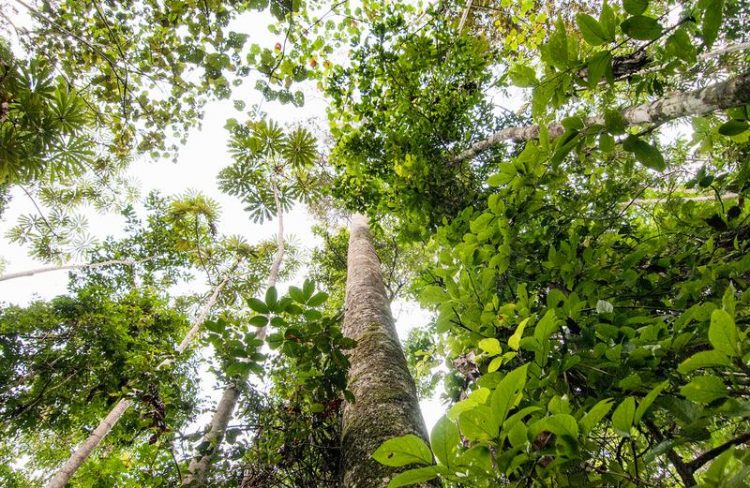Blacklists Protect the Rainforest

Deforestation of the rainforest is declining. Brazil has been naming and shaming illegal deforestation – successfully, as researchers from the Center for Development Research have now shown. (c) Photo: Marco Simola/Center for International Forestry Research (CIFOR)
Deforestation in the Brazilian Amazon has declined recently. While in 2004, trees were still being felled on more than 27,000 square kilometers of land, the area was reduced to fewer than 10,000 square kilometers starting in 2009.
“There is a whole range of factors causing this,” says Elías Cisneros, Junior Researcher at the Center for Development Research (ZEF) and an employee of the Institute for Food and Resource Economics (ILR) at the University of Bonn. For instance, demand for internationally traded agrarian and forestry products also dropped in response to the financial crisis in 2008. However, Brazil’s environmental policy has played a key role in protecting the rainforest, as Cisneros has shown in his work with Sophie Lian Zhou (ILR) and Junior Professor Dr. Jan Börner (ZEF).
Public disclosure of districts with high deforestation rates
The researchers studied the effect of so-called blacklists – Brazilian authorities regularly publish the names of communities with the highest deforestation rates. “The media and non-governmental organizations can then increase pressure to hold responsible local actors accountable,” reports Börner. According to the researchers’ calculations, the “naming and shaming” policy has resulted in an approximately 26 percent drop in deforestation in recent years.
Brazil has used this political tool since 2008. Of the 771 districts in the Brazilian rainforest, “naming and shaming” was introduced in 50 areas with particularly high levels of deforestation. “Blacklisted municipalities may have been worried about economic penalties, among other things,” says Cisneros. This fear of losing market opportunities apparently helped to significantly reduce illegal deforestation.
How much deforestation would be taking place without the blacklists?
Stricter controls by authorities are another important factor. Controls are facilitated by Brazil’s modern satellite monitoring system. That makes it easier for inspectors to track down offenders of environmental laws on site. “However, our calculations showed that the blacklists are an important influencing factor in addition to the controls,” reports Cisneros. The researchers compared the listed communities with comparable non-listed communities. “Between 2008 and 2012, many blacklisted districts have apparently witnessed a collective effort to safeguard their reputation. This effort seems to have been an important driver in protecting more than 4,000 square kilometers, about 40 times the area of the Black Forest National Park in Germany,” says Börner in his summary of the findings.
Term paper as a basis for the study
The study is based on a term paper by Sophie Lian Zhou, a doctoral student at the Agricultural Science Department of the University of Bonn. She discovered the blacklisting policy in Börner’s master-level course on impact evaluation methods and started studying the policy in her final paper. “Börner and Cisneros were interested in the topic, so we pursued it further as a joint research project,” says Zhou. The result is a successful example of research-based teaching.
Publication: Naming and shaming for conservation: evidence from the Brazilian Amazon, trade journal “PLOS ONE”
Media contact:
Marco Elías Cisneros Tersitsch
Institute for Food and Resource Economics (ILR)
Department of Resources and Environmental Economics
University of Bonn
Tel. +49 228/731942
Email: e.cisneros@uni-bonn.de
Junior Prof. Dr. Jan Börner
Center for Development Research (ZEF)
University of Bonn
Tel. +49 228/731873
Email: jborner@uni-bonn.de
http://dx.plos.org/10.1371/journal.pone.0136402 Publication
https://blogazonia.wordpress.com/2015/09/23/shaming/ Blog Post
http://www.ilr.uni-bonn.de Institute for Food and Resource Economics (ILR)
http://www.zef.de/envpol.html Center for Development Research (ZEF)
Media Contact
All latest news from the category: Ecology, The Environment and Conservation
This complex theme deals primarily with interactions between organisms and the environmental factors that impact them, but to a greater extent between individual inanimate environmental factors.
innovations-report offers informative reports and articles on topics such as climate protection, landscape conservation, ecological systems, wildlife and nature parks and ecosystem efficiency and balance.
Newest articles

First-of-its-kind study uses remote sensing to monitor plastic debris in rivers and lakes
Remote sensing creates a cost-effective solution to monitoring plastic pollution. A first-of-its-kind study from researchers at the University of Minnesota Twin Cities shows how remote sensing can help monitor and…

Laser-based artificial neuron mimics nerve cell functions at lightning speed
With a processing speed a billion times faster than nature, chip-based laser neuron could help advance AI tasks such as pattern recognition and sequence prediction. Researchers have developed a laser-based…

Optimising the processing of plastic waste
Just one look in the yellow bin reveals a colourful jumble of different types of plastic. However, the purer and more uniform plastic waste is, the easier it is to…



